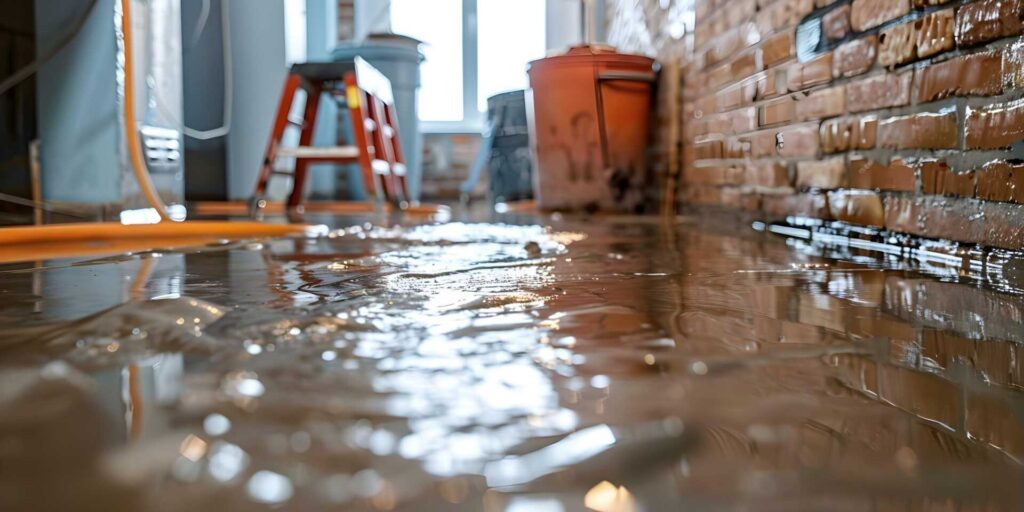
Contents
As the floodwaters recede, the mountain of flood cleanup ahead can seem daunting. You’ll need to don your armor—gloves, boots, and a mask—to safely navigate the debris and potential contaminants in your home. Start by swiftly assessing the damage; this critical first step can significantly impact your insurance claims and restoration efforts. But how do you ensure that the professionals you hire are up to the task, and what strategies can you employ to minimize future risks? Join the discussion below to uncover the essential steps that can help you restore normalcy and prepare better for any similar challenges ahead.
Key Takeaways
- Wear protective clothing such as rubber boots and gloves during cleanup to ensure safety.
- Quickly assess structural damage before entering any buildings for cleanup.
- Document all damage meticulously with photos and detailed lists for insurance purposes.
- Engage professional flood restoration services with verified credentials and positive reviews.
- Clear and maintain drainage systems regularly to prevent future flood damage.
Assessing the Damage Quickly
When a flood hits, quickly assessing the damage is crucial to mitigating further loss. As you stand in the aftermath, remember that you’re not alone. Your community is here to support you, and together, you’ll navigate this challenging time.
Begin your damage evaluation by conducting a thorough yet cautious walkthrough of your property. Wear protective clothing—rubber boots and gloves are a must. Check for visible structural damage, such as cracks or shifts in the foundation, before you enter any buildings. This initial check is about ensuring your safety and the safety of those with you.
Once inside, prioritize identifying areas where water has intruded. Look for water lines on walls to determine the extent of the flooding. Pay special attention to electrical systems. If you notice any exposed wires or water near electrical outlets, steer clear and note these hazards for professional attention.
Remember, the immediate goal isn’t to start repairs but to understand the impact and protect everyone from potential dangers.
Document everything. Use your phone or a camera to take pictures of the damage for insurance purposes and future reference. Make a list of damaged items. This documentation will be invaluable as you seek assistance and start the recovery process.
Finally, while it’s natural to want to start cleaning up immediately, prioritize your well-being and that of your community. Establish a safe area free from hazards where neighbors can gather, share information, and support each other.
Through this collective effort, you’ll find recovery and a renewed sense of community strength.
Choosing the Right Professionals
After assessing the flood damage, you’ll need to bring in the right professionals to start the recovery process. It’s crucial to choose a team that understands your needs and has the expertise to effectively tackle the challenges posed by flood damage. Here’s how you can ensure you’re making the best choice for your situation.
Start by researching contractors who specialize in flood damage restoration. Look for local experts with a solid reputation. You’re part of a community, and selecting someone from your area supports local businesses and means quicker response times. Check online reviews and ask your neighbors who they’ve trusted in similar situations.
Evaluating credentials is next. Ensure the professionals you consider are licensed, insured, and certified to deal with flood cleanup. Certifications from recognized industry organizations, like the Institute of Inspection, Cleaning and Restoration Certification (IICRC), are a good indicator of reputable service providers. Don’t hesitate to ask for proof of these credentials.
Once you’ve narrowed down your options, arrange to meet with the contractors. This is your chance to discuss your specific needs, ask about their process, and get a sense of their transparency and customer service.
Pay attention to how they communicate. Are they patient and clear? Do they make you feel like part of the recovery team? These interpersonal elements are often as important as technical capabilities in ensuring a smooth and supportive cleanup process.
Choosing the right professionals isn’t just about getting the job done—it’s about feeling supported and included in your community’s path to recovery.
Preventing Future Flood Risks
To reduce your risk of future floods, start by reevaluating your property’s landscaping. Implementing strategic changes can significantly curtail water buildup.
Consider installing rain gardens or using absorbent soil mixes that prevent runoff. These adjustments protect your home and contribute to a safer community environment.
Next, focus on your home’s structural integrity with proven floodproofing techniques. Elevating electrical systems, waterproofing basements, and installing backflow valves can prevent catastrophic damage.
It’s about safeguarding possessions and ensuring your space remains livable after the storm passes.
Don’t overlook the importance of routine maintenance in drainage improvement. Clear your gutters, downspouts, and drains regularly. A blockage can lead to water accumulation and, ultimately, floods.
By keeping these areas clean, you’re protecting your home and contributing positively to your neighborhood’s well-being.
Consider consulting with experts in flood risk assessment. These professionals can offer personalized advice tailored to your specific situation, providing peace of mind through customized solutions.
Review
As you tackle local emergency flood cleanup, remember that acting swiftly is key. Ensure you choose reputable professionals for the restoration and take proactive steps to mitigate future risks. By preparing and collaborating effectively, you’ll restore your property and strengthen your community’s resilience against future floods. Stay safe and stay informed.
Recent Posts
What Are Emergency Water Removal Services?
Imagine water pooling in your living room, threatening to damage your cherished belongings and compromise
How to Remove Water From Flooded Basements
Flooded basements affect nearly 14 million homes in the U.S. each year, making effective water
Your Guide to 24/7 Emergency Water Damage Repair
Did you know that the initial 48 hours after water damage are critical in preventing
